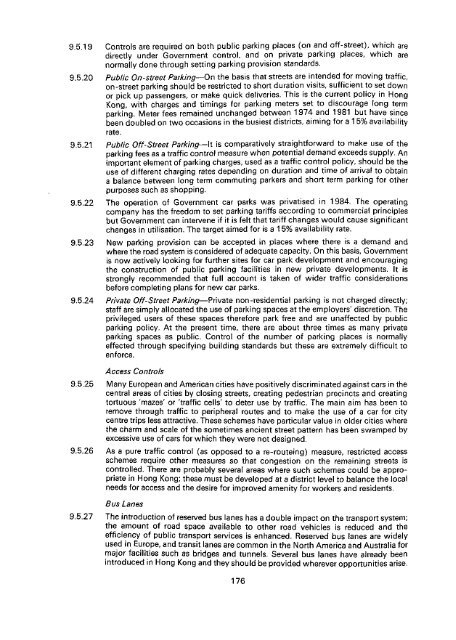Untitled - HKU Libraries - The University of Hong Kong
Untitled - HKU Libraries - The University of Hong Kong
Untitled - HKU Libraries - The University of Hong Kong
- No tags were found...
You also want an ePaper? Increase the reach of your titles
YUMPU automatically turns print PDFs into web optimized ePapers that Google loves.
9.5.19 Controls are required on both public parking places (on and <strong>of</strong>f-street), which aredirectly under Government control, and on private parking places, which arenormally done through setting parking provision standards.9.5.20 Public On-street Parking—On the basis that streets are intended for moving traffic,on-street parking should be restricted to short duration visits, sufficient to set downor pick up passengers, or make quick deliveries. This is the current policy in <strong>Hong</strong><strong>Kong</strong>, with charges and timings for parking meters set to discourage long termparking. Meter fees remained unchanged between 1974 and 1981 but have sincebeen doubled on two occasions in the busiest districts, aiming for a 15% availabilityrate.9.5.21 Public Off-Street Parking—It is comparatively straightforward to make use <strong>of</strong> theparking fees as a traffic control measure when potential demand exceeds supply. Animportant element <strong>of</strong> parking charges, used as a traffic control policy, should be theuse <strong>of</strong> different charging rates depending on duration and time <strong>of</strong> arrival to obtaina balance between long term commuting parkers and short term parking for otherpurposes such as shopping.9.5.22 <strong>The</strong> operation <strong>of</strong> Government car parks was privatised in 1984. <strong>The</strong> operatingcompany has the freedom to set parking tariffs according to commercial principlesbut Government can intervene if it is felt that tariff changes would cause significantchanges in utilisation. <strong>The</strong> target aimed for is a 15% availability rate.9.5.23 New parking provision can be accepted in places where there is a demand andwhere the road system is considered <strong>of</strong> adequate capacity. On this basis, Governmentis now actively looking for further sites for car park development and encouragingthe construction <strong>of</strong> public parking facilities in new private developments. It isstrongly recommended that full account is taken <strong>of</strong> wider traffic considerationsbefore completing plans for new car parks.9.5.24 Private Off-Street Parking—Private non-residential parking is not charged directly;staff are simply allocated the use <strong>of</strong> parking spaces at the employers' discretion. <strong>The</strong>privileged users <strong>of</strong> these spaces therefore park free and are unaffected by publicparking policy. At the present time, there are about three times as many privateparking spaces as public. Control <strong>of</strong> the number <strong>of</strong> parking places is normallyeffected through specifying building standards but these are extremely difficult toenforce.Access Controls9.5.25 Many European and American cities have positively discriminated against cars in thecentral areas <strong>of</strong> cities by closing streets, creating pedestrian precincts and creatingtortuous 'mazes' or 'traffic cells' to deter use by traffic. <strong>The</strong> main aim has been toremove through traffic to peripheral routes and to make the use <strong>of</strong> a car for citycentre trips less attractive. <strong>The</strong>se schemes have particular value in older cities wherethe charm and scale <strong>of</strong> the sometimes ancient street pattern has been swamped byexcessive use <strong>of</strong> cars for which they were not designed.9.5.26 As a pure traffic control (as opposed to a re-routeing) measure, restricted accessschemes require other measures so that congestion on the remaining streets iscontrolled. <strong>The</strong>re are probably several areas where such schemes could be appropriatein <strong>Hong</strong> <strong>Kong</strong>; these must be developed at a district level to balance the localneeds for access and the desire for improved amenity for workers and residents.Bus Lanes9.5.27 <strong>The</strong> introduction <strong>of</strong> reserved bus lanes has a double impact on the transport system;the amount <strong>of</strong> road space available to other road vehicles is reduced and theefficiency <strong>of</strong> public transport services is enhanced. Reserved bus lanes are widelyused in Europe, and transit lanes are common in the North America and Australia formajor facilities such as bridges and tunnels. Several bus lanes have already beenintroduced in <strong>Hong</strong> <strong>Kong</strong> and they should be provided wherever opportunities arise.176
















